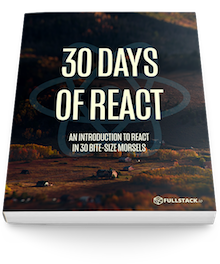Now that we know what React is, let's take a look at a few terms and concepts that will come up throughout the rest of the series.
In our previous article, we looked at what React is and discussed at a high-level how it works. In this article, we're going to look at one part of the React ecosystem: ES6 and JSX.
JSX/ES5/ES6 WTF??!
In any cursory search on the Internet looking for React
material, no doubt you have already run into the terms
JSX, ES5, and ES6. These opaque acronyms can get
confusing quickly.
ES5 (the ES stands for ECMAScript) is basically
"regular JavaScript." The 5th update to JavaScript,
ES5 was finalized in 2009. It has been supported by all major
browsers for several years. Therefore, if you've written
or seen any JavaScript in the recent past, chances are it was
ES5.
ES6 is a new version of JavaScript that adds some nice syntactical and functional additions. It was finalized in 2015. ES6 is almost fully supported by all major browsers. But it will be some time until older versions of web browsers are phased out of use. For instance, Internet Explorer 11 does not support ES6, but has about 12% of the browser market share.
In order to reap the benefits of ES6 today, we have to do a few things to get it to work in as many browsers as we can:
- We have to transpile our code so that a wider range of browsers understand our JavaScript. This means converting ES6 JavaScript into ES5 JavaScript.
- We have to include a shim or polyfill that provides additional functionality added in ES6 that a browser may or may not have.
We'll see how we do this a bit later in the series.
Most of the code we'll write in this series will be easily translatable to ES5. In cases where we use ES6, we'll introduce the feature at first and then walk through it.
As we'll see, all of our React components have a
render function that specifies what the HTML
output of our React component will be.
JavaScript eXtension, or more commonly
JSX, is a React extension that allows us to
write JavaScript that looks like HTML.
Although in previous paradigms it was viewed as a bad habit to include JavaScript and markup in the same place, it turns out that combining the view with the functionality makes reasoning about the view straight-forward.
To see what this means, imagine we had a React component that
renders an h1 HTML tag. JSX allows us to declare
this element in a manner that closely resembles HTML:
class HelloWorld extends React.Component {
render() {
return (
<h1 className='large'>Hello World</h1>
);
}
}
The render() function in the
HelloWorld component looks like it's
returning HTML, but this is actually JSX. The JSX is
translated to regular JavaScript at runtime. That
component, after translation, looks like this:
class HelloWorld extends React.Component {
render() {
return (
React.createElement(
'h1',
{className: 'large'},
'Hello World'
)
);
}
}
While JSX looks like HTML, it is actually just a terser way to
write a React.createElement() declaration. When a
component renders, it outputs a tree of React elements or a
virtual representation of the HTML elements
this component outputs. React will then determine what changes
to make to the actual DOM based on this React element
representation. In the case of the
HelloWorld component, the HTML that React writes
to the DOM will look like this:
<h1 class='large'>Hello World</h1>
The
class extendssyntax we used in our first React component is ES6 syntax. It allows us to write objects using a familiar Object-Oriented style. In ES5, theclasssyntax might be translated as:var HelloWorld = function() {} Object.extends(HelloWorld, React.Component) HelloWorld.prototype.render = function() {}
Because JSX is JavaScript, we can't use JavaScript
reserved words. This includes words like
class and for.
React gives us the attribute className. We use it
in HelloWorld to set the large class
on our h1 tag. There are a few other attributes,
such as the for attribute on a label that React
translates into htmlFor as for is
also a reserved word. We'll look at these when we start
using them.
If we want to write pure JavaScript instead of rely on a JSX
compiler, we can just write the
React.createElement() function and not worry
about the layer of abstraction. But we like JSX. It's
especially more readable with complex components. Consider the
following JSX:
<div>
<img src="profile.jpg" alt="Profile photo" />
<h1>Welcome back Ari</h1>
</div>
The JavaScript delivered to the browser will look like this:
React.createElement("div", null,
React.createElement("img", {src: "profile.jpg", alt: "Profile photo"}),
React.createElement("h1", null, "Welcome back Ari")
);
Again, while you can skip JSX and write the latter directly, the JSX syntax is well-suited for representing nested HTML elements.
Now that we understand JSX, we can start writing our first React components. Join us tomorrow when we jump into our first React app.




